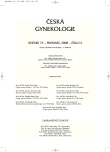Efficacy and Safety of Solifenacin in Daily Clinical Practice – Clinical Study Phase IV
Authors:
J. Krhut; O. Havránek; D. Míka; M. Fabišovský; P. Vališ
Authors‘ workplace:
Urologické oddělení FN Ostrava – Poruba, primář MUDr. J. Krhut, Ph. D.
Published in:
Ceska Gynekol 2008; 73(6): 370-375
Overview
Objective:
Symptoms of urinary urgency, frequency, nocturia with/or without urge incontinence, are reffered to as the overactive bladder (OAB). Main option for the treatment of the OAB are anticholinergic agents. The aim of the paper is to evaluate the efficacy and safety of the solifenacin in the daily clinical practice.
Material and methods:
344 patients with OAB symptoms (311 women, 33 men, average age 57,04 years) were enrolled into the study. Patients were treated with solifenacin 5 mg or solifenacin 10 mg in the flexible dosing regimen.
Efficacy data were obtained from the validated questionnaries and micturion diaries. Safety assessment was based on adverse event reporting.
Results:
We observed a highly significant reduction of bladder problems caused by OAB (Patient Perception of Bladder Condition – PPBC/PBC score 4.83 at baseline to 3.29 at endpoint). The decrease of micturion frequency from baseline to endpoint was 31.19 %, decrease of episodes of nocturia was 54.65 % and decrease of incontinence episodes was 90.19%.
Average number of urgency episodes decresed from 12.46/day at baseline to 7.28/day at endpoint (41.6%). Average urgency severity decreased from 2.43 at baseline to 1.55 at endpoint (-37.4%).
Adverse events were reported in 19 patients (5.52%) between visits 1 and 2 and in 16 patients (4,68%) between visits 2 and 3.
Conclusions:
Results of our phase IV. study showed the excellent efficacy and safety profile of solifenacin in the treatment of OAB in accordance with results of published phase III. clinical studies.
Key words:
urinary incontinence, detrusor, urgency, anticholinergics.
Sources
1. Abrams, P., Wein, AJ. The overactive bladder: from basic science to clinical management. Urology, 1997, 50,Suppl. 6, p. 1-3.
2. Milsom, I., Abrams, P., Cardozo, L., et al. How widespread are the symptoms of an overactive bladder and how are they managed? A population-based prevalence study. BJU Int, 2001, 87, p. 760-766.
3. Scarpero, HM., Dmochowski, RR. Muscarinic receptors: what we know. Curr Urol Rep, 2003, 4, 6, p. 421-428.
4. Viktrup, L., Summers, KH., Dennett, SL. Clinical practice guidelines for the initial management of urinary incontinence in women: a European-focused review. BJU Int, 2004, 94, Suppl 1, p. 14-22.
5. Martan, A. Novinky v medikamentózní léčbě inkontinence moči u žen. Čas lék čes, 2006, 145, 7, p. 549-553.
6. Coyne, KS., Matza, LS., Kopp, Z., et al. The validation of the patient perception of bladder condition (PPBC): a single-item global measure for patients with overactive bladder. Eur Urol, 2006, 49, 6, p. 1079-1086.
7. Cardozo, L., Coyne, KS., Versi, E. Validation of the urgency perception scale. BJU Int, 2005, 95, 4, p. 591-596.
8. Millard, RJ., Halaska, M. Efficacy of solifenacin in patients with severe symptoms of overactive bladder: a pooled analysis. Curr Med Res Opin, 2006, 22, 1, p. 41-48.
9. Chapple, CR., Cardozzo, L., Steers, WD., et al. Solifenacin significantly improves all symptoms of overactive bladder syndrome. Int J Clin Pract, 2006, 60, 8, p. 959-966.
10. Haab, F., Cardozo, L., Chapple, C., et al. Long-term open-label solifenacin treatment asociated with persistence with therapy in patients with overactive bladdder syndrome. Eur Urol, 2005, 47, p. 376-384.
11. Kelleher, CJ., Cardozo, L., Chapple, C., et al. Improved quality of life in patients with overactive bladder symptoms treated with solifenacin. BJU Int, 2005, 95, p. 81-85.
Labels
Paediatric gynaecology Gynaecology and obstetrics Reproduction medicineArticle was published in
Czech Gynaecology

2008 Issue 6
Most read in this issue
- Dilemma of the Results Interpretation of Molecular Genetic Analysis with a Focus on CFTR Gene Mutations in Men with Reproductive Disorders and in Gamete Donors
- Validity of Hysteroscopy in Clinical Setting: Single Centre Analysis of 605 Consecutive Hysteroscopies
- The Clinical Significance of Sentinel Lymph Node Micrometastases in Breast Cancer
- Efficacy and Safety of Solifenacin in Daily Clinical Practice – Clinical Study Phase IV
